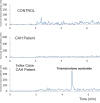Analysis of a pitfall in congenital adrenal hyperplasia newborn screening: evidence of maternal use of corticoids detected on dried blood spot
- PMID: 35521805
- PMCID: PMC9254290
- DOI: 10.1530/EC-22-0101
Analysis of a pitfall in congenital adrenal hyperplasia newborn screening: evidence of maternal use of corticoids detected on dried blood spot
Abstract
Neonatal screening for congenital adrenal hyperplasia (CAH) faces many specific challenges. It must be done using a performant analytical approach that combines sensitivity and specificity to capture the potential causes of mortality during the first week of life, such as salt wasting and glucocorticoid deficiency. Here, we confirm that maternal inhaled corticosteroid intake during pregnancy is a possible cause of missed CAH diagnosis. Thanks to liquid chromatography coupled with tandem mass spectrometry (LC-MS/MS) analysis, we were able to quantify endogenous steroid metabolites and also detect the presence of exogenous steroids in the dried blood spot of a newborn. Adding LC-MS/MS analysis as second-tier test, especially one that includes both 17-hydroxyprogesterone and 21-deoxycortisol measurements, would probably improve CAH diagnosis. In familial neonatal screening one could also look for maternal corticosteroid therapies that are hidden to prevent false-negative tests.
Keywords: 17-hydroxyprogesterone; CAH; dried blood spot; glucocorticoid treatment; newborn screening.
Figures
Similar articles
-
Steroid profile in dried blood spots by liquid chromatography tandem mass spectrometry: Application to newborn screening for congenital adrenal hyperplasia in China.Steroids. 2022 Sep;185:109056. doi: 10.1016/j.steroids.2022.109056. Epub 2022 May 31. Steroids. 2022. PMID: 35660382
-
Steroid profiling for congenital adrenal hyperplasia by tandem mass spectrometry as a second-tier test reduces follow-up burdens in a tertiary care hospital: a retrospective and prospective evaluation.J Perinat Med. 2014 Jan;42(1):121-7. doi: 10.1515/jpm-2013-0154. J Perinat Med. 2014. PMID: 23989111 Clinical Trial.
-
Twenty Years of Neonatal Screening for Congenital Adrenal Hyperplasia in North-Eastern Italy: Role of Liquid Chromatography-Tandem Mass Spectrometry as a Second-Tier Test.Horm Res Paediatr. 2022;95(3):255-263. doi: 10.1159/000524170. Epub 2022 Mar 29. Horm Res Paediatr. 2022. PMID: 35350013
-
Newborn screening for congenital adrenal hyperplasia: Utility of liquid chromatography with tandem mass spectrometry as a secondary test.Clin Pediatr Endocrinol. 2025 Jan;34(1):13-18. doi: 10.1297/cpe.2024-0069. Epub 2024 Nov 25. Clin Pediatr Endocrinol. 2025. PMID: 39777132 Free PMC article. Review.
-
The use of liquid chromatography-tandem mass spectrometry in newborn screening for congenital adrenal hyperplasia: improvements and future perspectives.Front Endocrinol (Lausanne). 2023 Oct 2;14:1226284. doi: 10.3389/fendo.2023.1226284. eCollection 2023. Front Endocrinol (Lausanne). 2023. PMID: 37850096 Free PMC article. Review.
References
-
- Hannon WH.Clinical, Laboratory Standards I. Blood Collection on Filter Paper for Newborn Screening Programs. Wayne, PA, USA: Approved Standard. Clinical and Laboratory Standards; Institute, 2013.
-
- Lacey JM, Minutti CZ, Magera MJ, Tauscher AL, Casetta B, McCann M, Lymp J, Hahn SH, Rinaldo P, Matern D. Improved specificity of newborn screening for congenital adrenal hyperplasia by second-tier steroid profiling using tandem mass spectrometry. Clinical Chemistry 200450621–625. (10.1373/clinchem.2003.027193) - DOI - PubMed
-
- Janzen N, Peter M, Sander S, Steuerwald U, Terhardt M, Holtkamp U, Sander J. Newborn screening for congenital adrenal hyperplasia: additional steroid profile using liquid chromatography-tandem mass spectrometry. Journal of Clinical Endocrinology and Metabolism 2007922581–2589. (10.1210/jc.2006-2890) - DOI - PubMed
LinkOut - more resources
Full Text Sources


